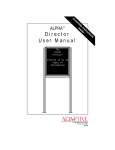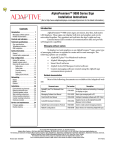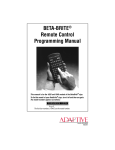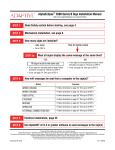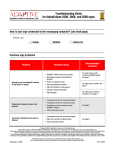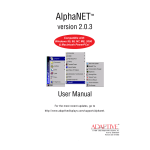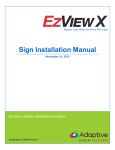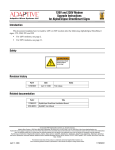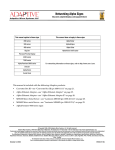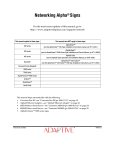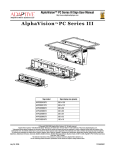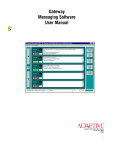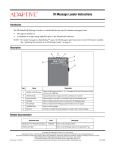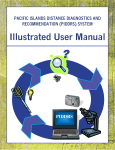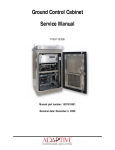Download Director™ Sign User Manual
Transcript
Director™ Sign User Manual (pn 9702-2005A) 4/15/2002 Director™ Sign User Manual The most recent update of this manual can be found at Adaptive’s Web site: http://www.adaptivedisplays.com Manual part number: 9702-2005A Revision date: 4/15/2002 1 Director™ Sign User Manual (pn 9702-2005A) 4/15/2002 NOTE: Due to continuing product innovation, specifications in this manual are subject to change without notice. © Copyright 2002 Adaptive Micro Systems, Inc. All rights reserved. Adaptive Micro Systems 7840 North 86th Street Milwaukee, WI 53224 USA 414-357-2020 414-357-2029 (fax) http://www.adaptivedisplays.com The following are trademarks of Adaptive Micro Systems: Adaptive, Alpha, AlphaNet plus, AlphaNET 2.0, AlphaEclipse, AlphaPremiere, AlphaTicker, AlphaVision, AlphaVision InfoTracker, Automode, BetaBrite, BetaBrite Director, BetaBrite Messaging Software, Big Dot, PPD, Smart Alec, Solar, TimeNet. The distinctive trade dress of this product is a trademark claimed by Adaptive Micro Systems, Inc. 2 Director™ Sign User Manual (pn 9702-2005A) 4/15/2002 Contents 1 Introduction.......................................................................... 6 Purpose ......................................................................................................................................................6 Revision history..........................................................................................................................................6 Related documentation...............................................................................................................................6 Controlling electrostatic discharge (ESD) ...................................................................................................7 Safety information ......................................................................................................................................7 Equipment symbols.............................................................................................................................7 Warnings and cautions........................................................................................................................8 2 Equipment overview................................................................ 9 Technical specifications............................................................................................................................10 Wood case ........................................................................................................................................10 Aluminum case..................................................................................................................................10 EMI compliance........................................................................................................................................10 3 Sign installation and setup...................................................... 11 Mounting the wood Director™..................................................................................................................12 Wall mounting ...................................................................................................................................12 Stand mounting (without brochure rack) ..........................................................................................13 Stand mounting (with brochure rack) ...............................................................................................16 Mounting the aluminum Director™...........................................................................................................20 Wall mounting ...................................................................................................................................20 Stand mounting.................................................................................................................................21 Connecting signs to a computer...............................................................................................................23 One sign to one computer .................................................................................................................23 Multiple signs to a network ...............................................................................................................24 4 Software installation and setup ................................................ 25 Installing the software ..............................................................................................................................26 Setting up the software.............................................................................................................................27 5 Using the remote control ........................................................ 28 Overview...................................................................................................................................................28 Turning a sign on and off .........................................................................................................................29 Setting a sign’s time and date...................................................................................................................30 Clearing a sign’s memory .........................................................................................................................32 Setting a sign’s password.........................................................................................................................33 How to set a sign’s password............................................................................................................33 Forgetting a sign’s password ............................................................................................................34 Deleting a sign’s password................................................................................................................34 Using the remote control’s sound control ................................................................................................35 Setting a sign’s serial address ..................................................................................................................35 Contents 3 Director™ Sign User Manual (pn 9702-2005A) 6 4/15/2002 Beginning text messaging....................................................... 36 Example 1—Using upper and lower text ..................................................................................................36 Example 2—Displaying messages in PAGE number order (A, B, C).........................................................40 Example 3—Displaying messages in time order ......................................................................................42 Example 4—Changing the text of an existing message ............................................................................44 Example 5—Deleting messages ...............................................................................................................46 7 Advanced text messaging ....................................................... 47 Example 6—Displaying the time and date ................................................................................................47 Example 7—Using the FLASH mode to highlight information ..................................................................51 Example 8—Using fonts and colors .........................................................................................................53 Example 9—International characters........................................................................................................56 8 Appendices ........................................................................ 57 Appendix A—Quick Reference Card .........................................................................................................57 Appendix B—Sign diagnostic test ............................................................................................................58 Appendix C—Transferring a sign’s memory from one sign to another.....................................................59 Appendix D—Using the IR Message Loader.............................................................................................60 Appendix E—Updating the firmware (wood Director™) ...........................................................................62 Appendix F—DIP switch access (aluminum Director™) ...........................................................................63 Appendix G—DIP switch settings (aluminum Director™) ........................................................................64 Appendix H—RS232 in and echo out (aluminum Director™)...................................................................65 4 Contents Director™ Sign User Manual (pn 9702-2005A) 4/15/2002 Warranty Adaptive Micro Systems, Inc. warrants to the original purchaser that the sign, keyboard, and power supply will be free of defects in workmanship and materials for a period of one year from the date of purchase. Adaptive Micro Systems, Inc. will without charge, repair or replace, at its option, defective product or component parts upon delivery to the factory service department accompanied by proof of the date of purchase in the form of a sales receipt. This warranty does not apply in the event of any misuse or abuse of the product, or as a result of any unauthorized repairs or alterations. This warranty does not apply if the serial number is altered, defaced or removed from the sign. Incandescent lamps used in incandescent products are not covered by this warranty. The purchase price of this product does not include, from Adaptive Micro Systems, Inc., any on-site support, service or maintenance. Local ordinances prohibiting the use of flashing signs may exist in some locations. Compliance with local ordinances is the sole responsibility of the customer. To obtain warranty coverage, this product must be registered. Please complete the enclosed warranty registration card and mail it to Adaptive Micro Systems, Inc. How to obtain warranty service Contact the distributor from whom the sign was purchased. If you do not know where the product was purchased, contact Adaptive Micro Systems Customer Service at 414-357-2020. Contents 5 Director™ Sign User Manual (pn 9702-2005A) 4/15/2002 1—Introduction Purpose This manual is intended as a guide for installation and setup of a Director™ sign, as well as for basic sign operation and text messaging. Revision history Revision Date Notes 9704-3006 08/26/1998 Installation and setup manual for wood Director™ only 9702-2005 11/15/2001 Installation and setup manual for aluminum Director™ only 9702-2005A 04/15/2002 Installation and setup manual for wood and aluminum Director™ Related documentation Technical documentation can be found at Adaptive’s Web site: http://www.adaptivedisplays.com. Part # Description 9700-0112 Networking Alpha Signs Describes how to network standard product Alpha signs. 9701-0202 Messaging Software User Manual Provides step-by-step examples on how to use the Alpha® Messaging Software Director™ Edition. 9707-1003 IR Message Loader Instructions Explains how to use the Infrared Message Loader to transfer messages between display signs and PCs. Preventing Electrostatic Discharge (ESD) Damage Describes grounding practices and provides work area guidelines when working on signs. TechMemo 00-0005 6 Manual title 1—Introduction Director™ Sign User Manual (pn 9702-2005A) 4/15/2002 Controlling electrostatic discharge (ESD) ATTENTION OBSERVE PRECAUTIONS ELECTROSTATIC SENSITIVE DEVICE Adaptive signs contain components that may be damaged by electrostatic discharge, or static electricity. Follow the guidelines in Adaptive Tech Memo 00-0005, “Preventing Electrostatic Discharge (ESD) Damage,” available on our Web site at http://www.adaptivedisplays.com. Safety information Equipment symbols Chassis ground 1—Introduction 7 Director™ Sign User Manual (pn 9702-2005A) 4/15/2002 Warnings and cautions WARNING WARNING Possible fire hazard. Always mount unit indoors. Mounting the unit outdoors may cause a fire which could result in serious injury or death. Possible shock hazard. Always mount unit indoors. Mounting a unit outdoors makes the unit a possible source of electric shock which could result in serious injury or death. WARNING WARNING Hazardous voltage. Contact with high voltage may cause death or serious injury. Always disconnect power to unit prior to servicing. No circuit breaker or switch in sign. Contact with high voltage may cause death or serious injury. Always disconnect all power to sign prior to servicing. WARNING WARNING Possible crush hazard. Mounting system must be able to safely support the unit's weight. Otherwise the unit may fall, causing serious injury or death. Hazardous leakage current. Contact with sign may cause death or serious injury. Earth ground essential before connecting supply. WARNING 8 1—Introduction Director™ Sign User Manual (pn 9702-2005A) 4/15/2002 2—Equipment overview The Director™ sign is an indoor LED sign that comes in either a wood or aluminum case. The sign can display up to eight 16-character (aluminum or wood) or 24-character (aluminum only) rows of text. The sign is capable of storing up to 26 screens of text information. The sign can either be hung from a wall or mounted on a stand. An optional brochure rack can be used with the wood Director™. The power receptacle must be installed near the equipment and easily accessible. Wood case Front and back view (without stand) Front view (with stand) Front view (with stand and brochure rack) Side view (with stand and brochure rack) Aluminum case Front and back view (without stand) 2—Equipment overview Front view (stand) Side view (with stand) 9 Director™ Sign User Manual (pn 9702-2005A) 4/15/2002 Technical specifications Wood case Item Sign Description Power 16 character 120/230 VAC, 150 W Dimensions (inches) 16 character 22.5L x 3.12D x 27H (57.2L x 7.9D x 68.6H cm) Weight (without stand) 16 character 31.1 lbs. (14.1 kg) Weight (with brochure rack and stand) 16 character 58.7 lbs. (26.6 kg) Aluminum case Item Power Dimensions Weight (without stand) Weight (with stand) Sign 16 character 24 character Description 100/240 VAC, 3.5 A, 50/60 Hz 16 character 25.45L x 2.82D x 27.49H (64.6L x 7.2D x 69.8H cm) 24 character 35.03L x 2.82D x 27.49H (89.0L x 7.2D x 69.8H cm) 16 character *30 lbs. (13.6 kg) 24 character *40 lbs. (18.1 kg) 16 character *85 lbs. (38.6 kg) 24 character *95 lbs. (43.1 kg) *Approximate EMI compliance This equipment has been tested and found to comply with the limits for a Class A digital device, pursuant to Part 15 of the FCC Rules. These limits are designated to provide reasonable protection against harmful interference when the equipment is operated in a commercial environment. This equipment generates, uses, and can radiate radio frequency energy and, if not installed and used in accordance with the instruction manual, may cause harmful interference to radio communications. Operation of this equipment in a residential area is likely to cause harmful interference in which case the user will be required to correct the interference at his own expense. 10 2—Equipment overview Director™ Sign User Manual (pn 9702-2005A) 4/15/2002 3—Sign installation and setup For more information on networking signs, see “Connecting signs to a computer” on page 23. For detailed information, see the Networking Alpha Signs manual, pn 9700-0112. WARNING Hazardous voltage. Contact with high voltage may cause death or serious injury. Always disconnect power to unit prior to servicing. WARNING CAUTION Remove sign from wall or stand before servicing. Otherwise, sign may fall or tip over causing serious injury. NOTE: Do not use the Director™ outdoors because water and dust will damage the sign. NOTE: Because of its weight, the Director™ should be assembled by two people. 3—Sign installation and setup 11 Director™ Sign User Manual (pn 9702-2005A) 4/15/2002 Mounting the wood Director™ Wall mounting 1. Make sure a wall mounting bracket is attached to the back of the sign. Wall mounting bracket (factory installed) This bottom panel flips open to expose the RS232/RS485 jacks, which are used to connect the sign to a computer or a network of signs. 2. Attach the wall mounting bracket (supplied) to a wall. Then hang the sign from this bracket. NOTE: Only hang this sign from a wall capable of supporting 116 pounds (52.5 kg). Attach a wall mounting bracket to a wall. 3. 12 To mount the sign, interlock the two brackets. Route the power cord from the sign in such a way that the cord is not in an area where people will be walking. 3—Sign installation and setup Director™ Sign User Manual (pn 9702-2005A) 4/15/2002 Stand mounting (without brochure rack) 1. Remove the caps from the top of each mounting pole. Remove each end cap by unfastening the two screws that hold each cap. Mounting poles 2. Place both mounting poles on a flat surface. Slide the crossbar down the channels on the mounting poles. Then slide a safety stop down each channel. Safety stops Crossbar 3—Sign installation and setup 13 Director™ Sign User Manual (pn 9702-2005A) 3. 4/15/2002 Fasten the crossbar to each mounting pole with the four set screws. Then fasten each safety stop with the two sets of screws. Safety stop Crossbar Fasten each safety stop with two screws. 25.5 inches (63.5 cm) Fasten with two screws on each side. Mounting notch—line up the bottom of the crossbar with this notch. NOTE: Screws should be securely tightened (18- to 20-inch/pounds of torque recommended). 14 3—Sign installation and setup Director™ Sign User Manual (pn 9702-2005A) 4. 4/15/2002 Place each of the sign’s mounting brackets in a channel on each mounting pole. Then slide the sign down until it rests on the safety stops. Finally, reattach the end caps to the tops of the mounting poles. End caps 5. Fasten the sign to the floor using four bolts or screws (not provided) in the locations shown below. Top view of sign 3—Sign installation and setup 15 Director™ Sign User Manual (pn 9702-2005A) 6. 4/15/2002 Route the power cord from the sign in such a way that the cord is not in an area where people will be walking. Run the power cord along one of the mounting poles. Use the supplied cable ties to fasten the power cord to the mounting pole. Fasten the power cord to the floor (using tape, for example) to prevent someone from tripping over it. Power cord Cable ties Completed assembly of sign Stand mounting (with brochure rack) 1. Remove the caps from the top of each mounting pole. Remove each end cap by unfastening the two screws that hold each cap. Mounting poles 16 3—Sign installation and setup Director™ Sign User Manual (pn 9702-2005A) 2. 4/15/2002 Place both mounting poles on a flat surface. Slide the crossbar down the channels on the mounting poles. Then slide a safety stop down each channel. Safety stops Crossbar 3. Fasten the crossbar to each mounting pole with the four set screws. Then fasten each safety stop with the two sets of screws. 43.5 inches (110.5 cm) Safety stop Crossbar Fasten each safety stop with two screws. Fasten the crossbar with two screws on each side. Mounting notch—line up the bottom of the crossbar with this notch. NOTE:Screws should be securely tightened (18- to 20-inch/pounds of torque recommended). 3—Sign installation and setup 17 Director™ Sign User Manual (pn 9702-2005A) 4. 4/15/2002 Place each of the brochure rack’s mounting brackets in a channel on each mounting pole. Slide the brochure rack down until it rests on the safety stops. Then slide the sign down the channels. Finally, reattach the end caps onto the tops of the mounting poles. End caps 18 3—Sign installation and setup Director™ Sign User Manual (pn 9702-2005A) 5. 4/15/2002 Fasten the sign to the floor using four bolts or screws (not provided) in the locations shown below. Top view of sign 6. Route the power cord from the sign in such a way that the cord is not in an area where people will be walking. Run the power cord along one of the mounting poles. Plastic case Use the supplied cable ties to fasten the power cord to the mounting pole. The plastic case can hold different sizes of literature. Use the supplied plastic dividers to adjust for these sizes. Fasten the power cord to the floor (using tape, for example) to prevent someone from tripping over it. Cable ties Crossbar To remove the plastic case: 1.Unscrew the 4 screws from the crossbar. 2.Slip the crossbar down. 3.Loosen the two screws on the inside bottom of the brochure rack. 4.Remove the wood bottom of the brochure rack. 5.Remove the plastic case from the brochure rack. 6.Reassemble the brochure rack. Power cord Completed assembly of sign 3—Sign installation and setup 19 Director™ Sign User Manual (pn 9702-2005A) 4/15/2002 Mounting the aluminum Director™ Wall mounting 1. Make sure a mounting bracket is attached to the back of the sign. Sign mounting bracket (factory-installed) 2. Attach the wall mounting bracket to a wall with fasteners (not provided). Then hang the sign from this bracket. NOTE: Both the wall and the fasteners must be capable of supporting 120 pounds (54.5 kg). Wall mounting bracket. This side attaches to the wall. Attach the wall mounting bracket to a wall. 3. 20 To mount the sign, interlock the two brackets. Plug the power cord into the back of the sign and route it from the sign in such a way that it is not in an area where people will be walking. 3—Sign installation and setup Director™ Sign User Manual (pn 9702-2005A) 4/15/2002 Stand mounting 1. Assemble the stand by attaching the pole to the base plate using six 1/4–20 x 1.25 inch Phillips flathead screws. A 0.266 diameter hole for mounting stand to floor. (Fasteners not provided.) 3—Sign installation and setup 21 Director™ Sign User Manual (pn 9702-2005A) 2. 4/15/2002 Attach the bottom bracket to the back of the sign, and to the front and top of the stand. Then attach the sign to the stand. Power cord entry All screws are 10–24 x 0.375 inch Power cord exit 3. 22 Plug the power cord into the back of the sign. Run the cord through the power cord entry on the front of the stand, down the interior of the stand, then out the power cord exit. 3—Sign installation and setup Director™ Sign User Manual (pn 9702-2005A) 4/15/2002 Connecting signs to a computer Connect the sign to a computer in order to send messages to it using Alpha® Messaging Software Director™ Edition. One sign to one computer 1. Remove power from the sign. WARNING Hazardous voltage. Contact with high voltage may cause death or serious injury. Always disconnect power to unit prior to servicing. 2. If you are connecting a wood Director™, make sure the sign’s internal RS232/RS485 jumper is set to RS232. The jumper is set automatically in the aluminum Director™. Remove the two screws holding the sign’s cap. 3—Sign installation and setup Remove the cap. Pull up and remove the clear plastic lens on the sign’s front. Then set the jumper over the two left (RS232) pins. 23 Director™ Sign User Manual (pn 9702-2005A) 3. 4/15/2002 Connect a personal computer to the sign as shown. A To sign’s RS232 jack on back of sign (under lower panel on wood Director™) B C To PC’s RS232 COM port PC running messaging software Director™ sign Item Part # Description A — Ferrite (ferrite end towards sign) 1088-8625 25-foot RS232 cable B 1088-8627 50-foot RS232 cable 4370-0001C RJ11-to-DB25 adapter (for a PC with a 25-pin RS232 port) C 1088-9108 RJ11-to-DB9 adapter (for a PC with a 9-pin RS232 port) Note: Part number 1036-9010, a 6-connector RS232 cable, can replace pn 1088-8625 and pn 1088-9108. Multiple signs to a network Because there are a variety of ways (for example, LAN, wireless, Ethernet, and so on) to connect networked signs, see the Networking Alpha Signs manual, PN 9700-0112, for more information. On a wood Director™, the sign’s internal RS232/RS485 jumper must be set to RS485. See page 23 for more information on setting the jumper. 24 3—Sign installation and setup Director™ Sign User Manual (pn 9702-2005A) 4/15/2002 4—Software installation and setup Messages can be sent to Director™ signs using either of two methods, the Alpha® Messaging Software Director™ Edition or the hand-held remote control. The Messaging Software User Manual, PN 9701-0202, is included in the installation of the software to provide you with specific information on how to send messages to a Director™ sign with the Director™ edition messaging software. It is located in your Windows® Start menu (Programs>Alpha Messaging Software Director Edition>User Manual). NOTE: Online help is available in the Director™ edition messaging software. It contains jumps to related topics for immediate access to the information you need, as well as popup windows that provide window-specific information that will help you move through the various procedures. Press the F1 key to access this help when in the software. The other way messages can be sent to the Director™ signs is by using a hand-held remote control. Information on text messaging with the remote is found starting on page 28. 4—Software installation and setup 25 Director™ Sign User Manual (pn 9702-2005A) 4/15/2002 Installing the software 1. Start Microsoft Windows® and be sure to have all other applications closed. 2. Insert the Alpha® Messaging Software Director™ Edition CD-ROM into your CD-ROM drive. The installation process will start automatically. NOTE: If the installation does not start automatically, run the install through your Windows® Start>Run menu, or double-click Setup.exe in your CD-ROM drive folder. 26 3. Follow the instructions when the installation program prompts you for a response. You will be given a choice as to which size Director™ display you want to send messages (the 16-character per line or the 24-character per line). Your choice determines what will appear in the title bar of the Alpha® Messaging Software Director™ Edition. You will also be given a chance to install Acrobat Reader, which you will need to view the messaging software manual included. 4. When the installation program is complete, the Alpha® Messaging Software Director™ Edition appears in your Start menu. 4—Software installation and setup Director™ Sign User Manual (pn 9702-2005A) 4/15/2002 Setting up the software Do the following only when you want to use a COM port other than COM1 (the default COM port): 1. Double-click Configuration Utility in the Start>Programs>Alpha Messaging Software Director Edition menu. 2. Select the appropriate COM port from the drop-down menu and click Next. 3. Select the type of Director™ sign to which you want to send messages or click Detect to have the software do it for you. Then click OK. The Configuration Utility will close automatically. 4. Open the software by double-clicking Start>Programs>Alpha Messaging Software Director Edition>Alpha Messaging Software. 4—Software installation and setup 27 Director™ Sign User Manual (pn 9702-2005A) 4/15/2002 5—Using the remote control Overview The remote control is a hand-held keyboard which emits infrared light and is used to program a sign. The remote control needs four AAA batteries to operate. They should be installed in the back of the control. The remote control can be used to turn a sign on and off, or to set its serial address. It can also be used to set its time and date, and to clear memory. However, the remote control’s most important—and most used—purpose is the creation of text messages and graphic images on a sign. To show you how to use the remote control, this manual presents practical, everyday examples. NOTE: A sign (or a network of signs) can also be programmed using a personal computer and special software. See the Networking Alpha Signs manual, PN 9700-0112, and your messaging software user manual for more detailed information.) Point this end of the remote control at a sign. Press PROGRAM to put the sign into programming mode. This mode is used to set the date and time, type in messages, and so on. To turn the sign on or off, hold down SHIFT and then press PROGRAM. Press RUN twice to exit programming mode. Use one of the SHIFT keys to access these white functions (such as TIME)... ...and these white characters (such as # and !). To use the remote control: 28 • Stand at least 5 feet and no more than 30 feet from the sign. • Make sure nothing reflective is in front of the sign. (Light from the sign’s display that is reflected back can interfere with the remote control.) 5—Using the remote control Director™ Sign User Manual (pn 9702-2005A) • 4/15/2002 If nearby fluorescent lights interfere with the remote control, you may have to relocate either the lights or the sign. If a sign is this far from the floor... ...then hold the remote control this far away: 10 feet from 10 to 30 feet 15 feet from 19 to 30 feet 20 feet from 25 to 30 feet Turning a sign on and off When you plug in the sign’s power supply, the sign starts up automatically, and unplugging the power supply turns the sign off. However, instead of unplugging a sign, there is another way to turn a sign off. Using the remote control, hold down SHIFT and then press PROGRAM. NOTE: Messages that you have programmed into the sign will not be lost when you turn a sign off. Messages will be retained for up to 30 days if the sign is not powered. When you turn a sign on, information similar to the following will appear: 1022-6414A LD016008P02TRI Version of firmware and model number of the sign. Copyright 2001 Copyright notice. Adaptive Micro Systems, Inc. Total amount of RAM in the sign. 64K RAM TUESDAY 3:12 PM The day and time set in the sign. FEB. 23, 2001 SERIAL ADDRESS = 00 The date set in the sign. Serial address of the sign (typically a number from 00 to 99). This number is used to provide a unique identity to a sign on a network. 5—Using the remote control 29 Director™ Sign User Manual (pn 9702-2005A) 4/15/2002 Setting a sign’s time and date Once set, a sign will remember the time and date for up to 30 days, even if the sign is unplugged or interrupted by a power loss. This is because it is equipped with a battery-backed real-time clock. Step When you do this... You see this... PROGRAM MODE 1 Press PROGRAM. THEN PAGE A MODE: [AUT] SPEED: [SP4] 2 SET TIME AND DAY Press BACK until SET TIME AND DAY appears. SET 3 4 Press ADV. Press D to set the day of the week. Press H to set the hour. Press M to set the minute. NOTE: Press SELECT to change from 12- (AM/PM) to 24-hour mode (0–23). 5 30 Press BACK until SET DATE appears. W/ D,H&M TUESDAY 3:54 PM SET W/ D,H&M TUESDAY 3:54 PM SET DATE 5—Using the remote control Director™ Sign User Manual (pn 9702-2005A) 4/15/2002 SET 6 Press ADV. W/ D,M,& Y THEN APR. 15, 2001 APR. 15, 2001 Press D to set the correct day. Press M to set the month. Press Y to set the year. 7 NOTE: Press SELECT to display the date in different formats—for example, APR 15, 2001 or 4/15/01, or 15/4/01, and so on. 8 After setting the date and time, press RUN twice to return to normal operation. 5—Using the remote control 31 Director™ Sign User Manual (pn 9702-2005A) 4/15/2002 Clearing a sign’s memory Clearing a sign’s memory erases the password and all messages that have been programmed into the sign. Step When you do this... You see this... PROGRAM MODE THEN 1 Press PROGRAM. PAGE A MODE: [AUT] SPEED:[SP4] 2 Press BACK until CLEAR MEMORY appears. CLEAR MEMORY WARNING ******* 3 Press ADV. THEN CLEAR ALL? Y/N 4 32 Press Y to clear the sign’s memory. The sign will return to normal operation and display a series of demo messages. 5—Using the remote control Director™ Sign User Manual (pn 9702-2005A) 4/15/2002 Setting a sign’s password You can set a personal password to protect your messages from tampering by others. If you forget your password, you won’t be able to operate the sign until you follow the steps on “Forgetting a sign’s password” on page 34. How to set a sign’s password Step When you do this... You see this... PROGRAM MODE 1 Press PROGRAM. PAGE A MODE: [AUT] SPEED:[SP4] 2 Press BACK until SET PASSWORD appears. 3 Press ADV. 4 Press Y to set a password. Type a 6-character password. (Only asterisks will appear on the sign as you type.) SET PASSWORD PASSWD ENTER Y/N 6 CHAR ****** THEN Retype the password when prompted. RE-ENTER THE 6 THEN 5 CORRECT CORRECT appears if you entered the same password. THEN If you failed to type the same password, ERROR will appear, and you’ll have to start over from step 1. 5—Using the remote control PAGE A MODE: [AUT] SPEED:[SP4] 33 Director™ Sign User Manual (pn 9702-2005A) 6 Press RUN twice. 4/15/2002 PASSWORD RUN? Y/ N SECURE Press Y to password protect the sign. THEN 7 NOTE: If you select N, a password will not be needed when you press PROGRAM. The sign will return to normal operation. Now, whenever you press PROGRAM, you’ll have to type the password you just entered. Forgetting a sign’s password Step 1 When you do this... Press PROGRAM. You see this... ENTER PASSWORD ****** THEN 2 Hold down SHIFT and press L six times. PAGE A MODE: [AUT] SPEED:[SP4] 3 Enter a new password. (See “Setting a sign’s password” on page 33.) Deleting a sign’s password If you no longer want to be prompted to password protect a sign, you must clear the sign’s memory in order to delete the password. To do this, see “Clearing a sign’s memory” on page 32. 34 5—Using the remote control Director™ Sign User Manual (pn 9702-2005A) 4/15/2002 Using the remote control’s sound control Normally, whenever you press a remote control key, the sign will beep. This lets you know that an action has been performed. To turn this feature off (or on again), hold down SHIFT and press RUN. Setting a sign’s serial address The serial address is a number that you can assign to a sign. Typically, this feature is used with a sign that is connected to other signs on a network. Giving a unique serial address to a sign allows you to send messages to that particular sign only. See the Networking Alpha Signs manual, PN 9700-0112, for detailed information on networking signs. Step When you do this... You see this... PROGRAM MODE 1 Press PROGRAM. 2 Press BACK until SET SERIAL ADDRESS appears. 3 Press ADV. SERIAL ADDRESS = 00 Type a number, such as 10. SERIAL ADDRESS = 10 4 SET SERIAL ADDRESS NOTE: A serial address is actually a number from 0 to 255 in hexadecimal (00 to FF). However, in typical use, entering a number from 00 to 99 is fine. NOTE: When a sign leaves the factory, its serial address is set to 00. 5 Press RUN twice to set the new serial address and return the sign to normal operation. 5—Using the remote control 35 Director™ Sign User Manual (pn 9702-2005A) 4/15/2002 6—Beginning text messaging This section shows you how to start creating messages for your sign using the remote control. Example 1—Using upper and lowercase text In this first example, you’ll display the following text on the sign: This is your first message. Your first message will look like this. This is your second message. Your second message will look like this. Step 1 When you do this... Press PROGRAM. The CAPS key changes between upper & lower case. You see this... Modes allow you to use a special effect, like flashing, on a message. In this case, AUTOMODE [AUT] is used. To change the mode, hold down SHIFT and press either 2 (WIPE), 4 (FLASH), 5 (HOLD), or 7 (AUTO). PAGE A MODE: [AUT] SPEED:[SP4] SPEED controls how fast a mode changes. To change SPEED, hold down SHIFT and press 8. [SP5] is the fastest speed and [SP1] is the slowest. [NHL] means “no hold”. 2 Press ADV. Type THIS IS YOUR. 3 36 Blinking cursor THIS IS YOUR NOTE: If you make a mistake while typing, press BACK to erase a letter. 6—Beginning text messaging Director™ Sign User Manual (pn 9702-2005A) 4 5 4/15/2002 Press RETURN to go to the next line. THIS IS YOUR Type FIRST MESSAGE. THIS IS YOUR FIRST MESSAGE. NOTE: To create the period (.), hold down SHIFT and press X. THIS IS YOUR FIRST MESSAGE. 6 Press RUN to display your first message. Because AUTOMODE [AUT] was used, the message will appear in different colors. Here’s how to create the second message: PAGE A MODE: [AUT] SPEED:[SP4] 7 Press PROGRAM. Your second message will be created in PAGE B. 8 Press B to switch to PAGE B. 6—Beginning text messaging PAGE B MODE: [AUT] SPEED:[SP4] (Your first message is still in PAGE A. You can create up to 26 separate messages using pages A through Z.) 37 Director™ Sign User Manual (pn 9702-2005A) 4/15/2002 WPUP = wipe up. PAGE B MODE: [WPUP] SPEED:[SP4] 9 Hold down SHIFT and then press 2 for WIPE. 10 Press ADV. 11 Press the round COLOR key until the cursor color stays green. 12 Type T. If you hold down SHIFT and press 2 again, the mode will change to WPDN (WIPE DOWN). You can also select wipe left and wipe right. T Press CAPS to change to lowercase text. 13 All these characters in this line should be green. This is your Then type his is your. 38 This is your 14 Press RETURN to go to the next line. 15 Press the round COLOR key until the cursor color stays red. 16 Type second message. 17 Press RETURN to go to the next line. This is your second message. 18 Press the round COLOR key until the cursor color stays amber. This is your second message. This is your All these characters in this line should be red. This is your second message. 6—Beginning text messaging Director™ Sign User Manual (pn 9702-2005A) 19 Using CAPS, SHIFT, and RETURN when necessary, type the following: The CAPS key changes between upper & lower case. 4/15/2002 All these characters in these lines should be amber. This is your second message. The CAPS key changes between upper & lower case. NOTE: The ampersand (&) is made by holding down SHIFT and pressing K. Here’s how to insert a blank line between the two sentences above. 20 Hold down SHIFT and press E to move the cursor up one line. Repeat this until the cursor is over the A in CAPS. This is your second message. The C PS key changes between upper & lower case. This is your second message. 21 Press INSERT to create a blank line. Use INSERT to create blank lines between text. (Use DELETE to remove blank lines.) The CAPS key changes between upper & lower case. This is your second message. 22 Press RUN to see the message. Notice that only the second message (PAGE B) is displayed. In the next example, you’ll see how to display multiple messages instead of just one. 6—Beginning text messaging The CAPS key changes between upper & lower case. 39 Director™ Sign User Manual (pn 9702-2005A) 4/15/2002 Example 2—Displaying messages in PAGE name order (A, B, C) Once you’ve programmed messages into the sign, you may want to set the order or sequence in which messages appear. This method will display messages by their PAGE name (A, B, C, and so on) in the order you set (C, A, B, for example). If you do not set the sequence, the messages will appear in alphabetical order. Step When you do this... You see this... This example continues where Example 1 left off. This example assumes that there are two messages (PAGE A and B) in the sign. PAGE B MODE: [WPUP] SPEED:[SP4] 1 Press PROGRAM. Since we’re continuing from Example 1, this would appear on the sign. DEMO or RUN may also appear here. 2 Press RUN. If RUN appears on the sign, go to the next step. 3 TIM TIM = displays messages in time order. DEMO = displays a set of demonstration messages. RUN = displays messages by PAGE order (A, B, C, and so on). RUN Otherwise, press SELECT until RUN appears. 4 40 Press B and then A. This will be the order (PAGE B, then PAGE A) in which messages are displayed on the sign. RUN BA 6—Beginning text messaging Director™ Sign User Manual (pn 9702-2005A) 4/15/2002 This is your second message. PAGE B message 5 Press RUN. The CAPS key changes between upper & lower case. THIS IS YOUR FIRST MESSAGE. PAGE A message These two messages will keep being displayed in this order until a new page order or a new message is entered. Using this method, you can program the order of some or all of the messages you’ve entered on a sign. 6—Beginning text messaging 41 Director™ Sign User Manual (pn 9702-2005A) 4/15/2002 Example 3 — Displaying messages in time order In Example 2, you set the order of messages by PAGE letter (A, B, C, and so on). However, that method could not specify an exact time when a message would appear. In this example, we’ll show you how to make a message start and stop at times you specify. Step When you do this... You see this... For this example, make sure that your sign’s internal clock has been accurately set. (See “Setting a sign’s time and date” on page 30.) This example continues where Example 1 left off. This example assumes that there are two messages (PAGE A and B) in the sign. In this example, we’ll program the sign to display the message in PAGE A on Monday through Friday from 1:20 PM to 1:30 PM. We’ll program the sign to always display the message in PAGE B. PAGE B MODE: [WPUP] SPEED:[SP4] Press PROGRAM. 1 (If PAGE B does not appear, press B to display it.) Since we’re continuing from Example 1, this would appear on the sign. ON ALWAYS is the default setting for a message. A message set to ON ALWAYS will run continuously. 2 TEXT B ON ALWAYS Hold down SHIFT and press 9 for TIME. Since PAGE B is already set up, we’ll go on to PAGE A. Press RUN twice. 3 Then press PROGRAM. 42 4 Press A. 5 Hold down SHIFT and press 9 for TIME. PAGE B MODE: [WPUP] SPEED:[SP4] PAGE A MODE: [AUT] SPEED:[SP4] TEXT A ON ALWAYS 6—Beginning text messaging Director™ Sign User Manual (pn 9702-2005A) 4/15/2002 First we’ll set the ON time (when this message will start on the sign): 6 TEXT A ON MO-FR 0:00 Press D (for day) until MO-FR appears. Press D to set the day, H for hour, and M for minute (in 10-minute increments). 7 TEXT A ON MO-FR 13:00 Press H (for hour) until 13:00 appears. Hours are represented in 24-hour or military style. So 1:00 PM = 13:00, 2:00 PM = 14:00, and so on. 8 TEXT A ON MO-FR 13:20 Press M (for minute) until 13:20 appears. Minutes are in increments of 10. 9 TEXT A OFF MO-FR 0:00 Press SELECT. After setting the on time, we’ll select the off time (when the message stops). 10 Repeat steps 6, 7, and 8 to set an off time (in this case,13:30). This message should appear continuously. The CAPS key changes between upper & lower case. Press RUN twice. This message should only appear between the on and off times you set. 6—Beginning text messaging PAGE A 11 PAGE B This is your second message. THIS IS YOUR FIRST MESSAGE. 43 Director™ Sign User Manual (pn 9702-2005A) 4/15/2002 Example 4 — Changing the text of an existing message After typing in a message, you may want to add or remove text from it. The following is an example of this common situation: Step When you do this... You see this... This example continues where Example 2 left off. This example assumes that there are two messages (PAGE A and B) in the sign. In this example, we’ll change PAGE A to the following: THIS IS YOUR VERY FIRST MESSAGE, BUT NOW IT’S LONGER 1 PAGE A MODE: [AUT] SPEED:[SP4] Press PROGRAM. Press RUN. Press SELECT until RUN appears. 2 RUN AB Press A and then B to set a run sequence. Finally, press RUN again. Press PROGRAM. PAGE A MODE: [AUT] SPEED:[SP4] 3 (If PAGE A does not display, press A.) 4 Press ADV. The cursor should be blinking over the first letter. HIS IS YOUR FIRST MESSAGE. How to move the cursor: SHIFT + E SHIFT + D SHIFT + F SHIFT + C 5 44 Hold down SHIFT and press C to move the cursor down one line. The cursor should be blinking over the first letter on the second line. THIS IS YOUR IRST MESSAGE. 6—Beginning text messaging Director™ Sign User Manual (pn 9702-2005A) 6 Try to type the word VERY. In order to make room for the word VERY, you’ll have to delete the word MESSAGE first. 7 4/15/2002 You’ll only be allowed to type the first two letters of VERY, because there must be enough room in a line to add the characters. THIS IS YOUR VE IRST MESSAGE. THIS IS YOUR VEFIRST MESSAGE. Move the cursor to the end of the word FIRST by holding down SHIFT and then pressing F. 8 Press DELETE until the word MESSAGE (and the period) is deleted. THIS IS YOUR VEFIRST 9 Hold down SHIFT and press D to move the cursor over the letter F. THIS IS YOUR VE IRST 10 Finish the word VERY by typing RY and a space. THIS IS YOUR VERY IRST Hold down SHIFT and press C to move down one line. THIS IS YOUR VERY FIRST 11 Then hold down SHIFT and press D until the cursor is at the start of the line. 12 Type MESSAGE, BUT NOW. The cursor moves to the next line automatically. Use SHIFT + W to create a comma. 13 14 Type IT’S LONGER. Press RUN to see your message. 6—Beginning text messaging Use SHIFT + V to create an apostrophe. THIS IS YOUR VERY FIRST MESSAGE, BUT NOW THIS IS YOUR VERY FIRST MESSAGE, BUT NOW IT'S LONGER THIS IS YOUR VERY FIRST MESSAGE, BUT NOW IT'S LONGER 45 Director™ Sign User Manual (pn 9702-2005A) 4/15/2002 Example 5 — Deleting messages To delete all the messages in a sign, see “Clearing a sign’s memory” on page 32. However, if you only want to delete selected messages, then use the method shown in this example. Step When you do this... You see this... This example continues where Example 4 left off. This example assumes that there are two messages (PAGE A and B) in the sign: PAGE A = THIS IS YOUR VERY FIRST MESSAGE, BUT NOW IT’S LONGER PAGE B = This is your second message. The CAPS key changes between upper & lower case. In this example, we’ll delete the PAGE B message: PAGE B MODE: [WPUP] SPEED:[SP4] Press PROGRAM. 1 (If PAGE B does not display, then press B.) 2 Press DELETE. 3 Press Y to delete the page. 4 46 Press RUN twice. DELETE FILE B Y/N PAGE B MODE: [AUT] SPEED:[SP4] Only the PAGE A message should appear. THIS IS YOUR VERY FIRST MESSAGE, BUT NOW IT'S LONGER 6—Beginning text messaging Director™ Sign User Manual (pn 9702-2005A) 4/15/2002 7—Advanced text messaging Before attempting the following, make sure you’re familiar with the previous examples in the 6— Beginning text messaging section of this manual. Example 6 — Displaying the time and date Step When you do this... You see this... In this example, we’ll create a message that continuously displays the current time and date: APR. 17, 2001 1:37 PM Current date and time (displayed in amber). This will be displayed in red. This will be displayed in green. Room E101 E200 W20 W130 This will be displayed in green. PAGE A (The first message you’ll enter.) APR. 17, 2001 1:37 PM Current date and time (displayed in amber). This will be displayed in red. Company Applied Eng United Wire ACME Tool Adv Maint Room Company S200 Generic Mfg S250 Bob’s Print PAGE B (The second message you’ll enter.) 1 Delete all the messages currently stored in the sign. (See “Clearing a sign’s memory” on page 32 or “Example 5 — Deleting messages” on page 46.) Press PROGRAM. 2 (If PAGE A does not display, press A.) Change the mode to WIPE DOWN. 3 Set the message transition speed to its fastest (SP5). 7—Advanced text messaging PAGE A MODE: [AUT] SPEED:[SP4] PAGE A MODE: [WPDN] SPEED:[SP5] Use SHIFT + 2 to change the mode. Use SHIFT + 8 to change the speed. 47 Director™ Sign User Manual (pn 9702-2005A) 4/15/2002 Press ADV. 4 Press COLOR until the cursor always blinks amber. Then press SPACE to move the cursor over two spaces. Here’s how to put the date in the message: 5 APR. 17, 2001 Hold down SHIFT and press 0. Press RETURN to start on a new line. APR. 17, 2001 6 Press COLOR until the cursor always blinks amber. Then press SPACE four times to move the cursor over. Here’s how to put the time in a message: 7 Hold down SHIFT and press 9. APR. 17, 2001 1:37 PM Now enter the rest of the PAGE A message: Press RETURN twice to skip down two lines. 8 Press COLOR until the cursor always blinks red. APR. 17, 2001 1:37 PM Room Company Using CAPS when necessary, type Room, a space, and then Company. Press RETURN again to start on a new line. Press COLOR until the cursor always blinks green. 9 Using CAPS when necessary, type E101, a space, and then Applied Eng. Repeat this process for the remaining lines of text. 48 APR. 17, 2001 1:37 PM Room E101 E200 W20 W130 Company Applied Eng United Wire ACME Tool Adv Maint 7—Advanced text messaging Director™ Sign User Manual (pn 9702-2005A) Press PROGRAM. Press B to go to PAGE B. 10 4/15/2002 PAGE B MODE: [WPLF] SPEED:[SP5] Change the mode to WIPE LEFT [WPLF]. Use SHIFT + 2 to change the mode. Use SHIFT + 8 to change the speed. Change the speed to the fastest [SP5]. 11 Press ADV. Current date and time (displayed in amber). 12 Using what you’ve just learned, type in the PAGE B message as shown: This should be in red. This should be in green. APR. 17, 2001 1:37 PM Room Company S200 Generic Mfg S250 Bob’s Print TIM 13 Press RUN. RUN 14 15 Press SELECT until RUN appears. Type A and then B to set the order in which the two messages will appear. 7—Advanced text messaging RUN AB 49 Director™ Sign User Manual (pn 9702-2005A) 4/15/2002 APR. 17, 2001 1:37 PM PAGE A message 16 Room E101 E200 W20 W130 Company Applied Eng United Wire ACME Tool Adv Maint Press RUN again to display the two messages. APR. 17, 2001 1:37 PM PAGE B message 50 Room Company S200 Generic Mfg S250 Bob’s Print 7—Advanced text messaging Director™ Sign User Manual (pn 9702-2005A) 4/15/2002 Example 7 — Using the FLASH mode to highlight information FLASH is a mode that you shouldn’t overuse. However, it is very handy if you want to call attention to a single item, like a time or room number, on a page: Step When you do this... You see this... In this example, we’ll continue from the previous example: APR. 17, 2001 1:37 PM To call attention to this room number, we’ll make it flash on and off. Room E101 E200 W20 W130 Company Applied Eng United Wire ACME Tool Adv Maint Press PROGRAM. PAGE A MODE: [WPDN] SPEED:[SP5] 1 (If PAGE A does not display, then press A.) Blinking cursor 2 Press ADV. APR. 17, 2001 1:37 PM Since this continues where the last example left off, this is what should appear for PAGE A. Room E101 E200 W20 W130 Company Applied Eng United Wire ACME Tool Adv Maint APR. 17, 2001 1:37 PM 3 Press A. 7—Advanced text messaging Room E101 E200 W20 W130 Company Applied Eng United Wire ACME Tool Adv Maint 51 Director™ Sign User Manual (pn 9702-2005A) 4/15/2002 APR. 17, 2001 1:37 PM 4 Hold down SHIFT and press C until the cursor is over the letter W in W20. Move the cursor here. Room E101 E200 20 W130 Company Applied Eng United Wire ACME Tool Adv Maint APR. 17, 2001 1:37 PM 5 Room E101 E200 20 W130 Hold down SHIFT and press 4 for FLASH. This entire line should now be flashing. Company Applied Eng United Wire ACME Tool Adv Maint APR. 17, 2001 1:37 PM 6 Room E101 E200 W20 W130 Move the cursor to in front of ACME Tool. Hold down SHIFT and press F to move the cursor. APR. 17, 2001 1:37 PM Hold down SHIFT and press 4. 7 This turns flashing off for the rest of the line. Company Applied Eng United Wire ACME Tool Adv Maint Room E101 E200 W20 W130 Now the only text flashing should be the room number (W20). Company Applied Eng United Wire ACME Tool Adv Maint APR. 17, 2001 1:37 PM 8 52 Press RUN to see the message. Room E101 E200 W20 W130 Company Applied Eng United Wire ACME Tool Adv Maint 7—Advanced text messaging Director™ Sign User Manual (pn 9702-2005A) 4/15/2002 Example 8 — Using fonts and colors Fonts are the way characters are displayed on a sign. In the world of printing and publishing, fonts are given names like Times or Helvetica, and qualities like serif or sans serif, font size (such as 12 point or 14 point), bold or italic, and so on. This sign can display two types of fonts: Upper and lowercase letters can be used with this font. Only uppercase letters can be used with this font. This is the first font. THIS IS THE SECOND FONT. WELCOME! This is the message we’ll create using both of the sign’s fonts. Hernia Movers “THE OF POTENTATE TOTIN’ FREIGHT” To change from one font to the other, press the FONT key. The following examples demonstrate how to use fonts on a sign: Step When you do this... Press PROGRAM. 1 (If PAGE C does not display, press C.) You see this... PAGE C MODE: [HLD] SPEED:[SP4] Using SHIFT + 5, change the MODE to Hold. 2 Press ADV. WELCOME! 3 Type the following message: 7—Advanced text messaging Hernia Movers “The potentate of totin’ freight” 53 Director™ Sign User Manual (pn 9702-2005A) 4/15/2002 WELCOME! 4 Move the cursor in front of the The potentate and then press FONT. Pressing FONT changes the entire line to a different font. Hernia Movers “THE POTENTATE of totin’ freight” (Pressing FONT again would restore the original font.) WELCOME! 5 Move the cursor in front of the word potentate and press FONT. All text after the cursor should change to the other font. Press FONT again to make the whole line the same font. 6 The FONT key can be used to change a whole line of text or just a single word. Hernia Movers “ T H E potentate of totin’ freight” WELCOME! Hernia Movers Then position the cursor in front of the remaining lines and change the font of each line. “THE OF POTENTATE TOTIN’ FREIGHT” WELCOME! 7 Press RUN to see your message. Hernia Movers “THE OF POTENTATE TOTIN’ FREIGHT” Here’s a demonstration of what colors can be used: Press PROGRAM. 8 (If PAGE D does not display, press D.) PAGE D MODE: [HLD] SPEED:[SP4] Using SHIFT + 5, change the MODE to Hold. 9 54 Press ADV. 7—Advanced text messaging Director™ Sign User Manual (pn 9702-2005A) Type COLOR 0 10 Then press RETURN. 4/15/2002 COLOR 0 should be red to start. When displayed in the message, it will cycle through several color schemes. COLOR 0 Press COLOR one time. 11 Type COLOR 1. COLOR 1 should be red. COLOR 0 COLOR 1 COLOR 2 should be green. COLOR 0 COLOR 1 COLOR 2 COLOR 3 should be amber. COLOR COLOR COLOR COLOR 0 1 2 3 COLOR COLOR COLOR COLOR COLOR 0 1 2 3 4 COLOR COLOR COLOR COLOR COLOR COLOR 0 1 2 3 4 5 COLOR COLOR COLOR COLOR COLOR COLOR COLOR 0 1 2 3 4 5 6 Then press RETURN. Press COLOR two times. 12 Type COLOR 2. Then press RETURN. Press COLOR three times. 13 Type COLOR 3. Then press RETURN. Press COLOR four times. 14 Type COLOR 4. Then press RETURN. COLOR 4 should be multi-colored with the same combination of colors for each character. Press COLOR five times. 15 Type COLOR 5. Then press RETURN. COLOR 5 should be multi-colored with a different combination of colors for each character. Press COLOR six times. 16 Type COLOR 6. Then press RETURN. 17 Each character in COLOR 6 should be a different color. Press RUN to see what all the colors look like in a running message. 7—Advanced text messaging 55 Director™ Sign User Manual (pn 9702-2005A) 4/15/2002 Example 9 — International characters International characters—like ü and é—can be included in messages. NOTE: International characters cannot be used with the small font. If they are, a question mark (?) will appear in place of the letter. The following table summarizes all the international characters that can be used: Move the cursor over a base character, like e. International Characters Base Characters RÉSUMÉS WELCOME! 56 Then press SELECT until the international character you want appears. (Use the CAPS button on the remote control for uppercase versus lowercase letters.) A C E I N O U Y ? ! $ â ä å Ä Å æ Æ á a A a Ç ç C c é ê ë è É E e ï î ì I i ñ Ñ N n ô ö ò Ö ó o O o ü û Ü ú U u ÿ Y y ¿ ? ¡ ! ¢ £ ¥ ƒ $ 7—Advanced text messaging Director™ Sign User Manual (pn 9702-2005A) 4/15/2002 8—Appendices Appendix A—Quick Reference Card Message control keys PROGRAM To turn the sign on or off, hold down SHIFT and then press PROGRAM. To enter messages, set the date and time, clear memory, and so on. Press PROGRAM and then BACK until the setting you want to change is shown. Then press ADV to change that setting. RUN Press two times to exit program mode. APPEND Not used. CURSOR Not used. SPECIAL Not used. FONT Changes between a small or large font. WIDTH Not used. COLOR Changes the color of text. Display modes and special keys 8—Appendices ROLL Not used. WIPE Hold down SHIFT and press 2 to use the WIPE mode in a message. Doing this more than once cycles through all the options for direction of the wipe. SCROLL Not used. FLASH Hold down SHIFT and press 4 to use the FLASH mode in a message. HOLD Hold down SHIFT and press 5 to use the HOLD mode in a message. ROTATE Not used. AUTO Hold down SHIFT and press 7 to use the AUTO mode in a message. SPEED Hold down SHIFT and press 8 to use the SPEED mode in a message. Doing this more than once cycles through all the options for speed. (SP1 = slowest, NHL = fastest) TIME Hold down SHIFT and press 9 to include the time in a message. DATE Hold down SPECIAL and press M to include the date in a message. 57 Director™ Sign User Manual (pn 9702-2005A) 4/15/2002 Appendix B—Sign diagnostic test Your sign can perform a diagnostic test to determine if all the LEDs are working properly. Step When you do this... You see this... PAGE A MODE: [AUT] SPEED:[SP4] 1 Press PROGRAM. 2 Press BACK until SET TIME AND DAY appears. 3 Press ADV. 4 Type TEST. 5 Press PROGRAM to exit the diagnostic test mode. SET TIME AND DAY SET 58 W/ D,H&M THURSDAY 3:59 PM The sign will go through a series a LED tests until PROGRAM is pressed again. 8—Appendices Director™ Sign User Manual (pn 9702-2005A) 4/15/2002 Appendix C—Transferring a sign’s memory from one sign to another You can transfer the messages from the memory of one sign to the memory of any another sign by completing the following steps. NOTE: To complete the transfer of memory from one sign to other signs, all signs must be connected together. For information on connecting signs, see “Connecting signs to a computer” on page 23. For detailed information, see the Networking Alpha Signs manual, PN 9700-0112. Step When you do this... You see this... PAGE A MODE: [AUT] SPEED:[SP4] 1 Press PROGRAM. 2 Press SPECIAL. 3 Press D. 4 The sending sign transmits all messages to the receiving sign and then resumes displaying messages as programmed. SPECIAL SENDING With the aluminum Director™, you can also use the RS485 echo feature to transfer a sign’s memory from one sign to another. Please refer to Appendix H—RS232 in and echo out RS485 (aluminum Director™) on page 56. 8—Appendices 59 Director™ Sign User Manual (pn 9702-2005A) 4/15/2002 Appendix D—Using the IR Message Loader The IR (InfraRed) Message Loader is a hand-held device used to transfer messages from one sign to another, or from a computer to a sign, using messaging software. C B E D A F G 60 Item Name Description A MEMORY LOCATION switch Allows you to select one of the three 10,000-byte memory partitions. B DATA VALID indicator Indicates valid data in the memory location currently selected. C Infrared transmitters Used to transmit messages stored in MEMORY LOCATIONS to signs. D DATA indicator When lit, indicates data is being sent or received via the serial port or the infrared transmitters. E BAT. LOW indicator When lit, indicates that the battery should be replaced. F TRANSMIT button When transferring a message from a PC into the IR Message Loader, pressing this button stores the message in the selected MEMORY LOCATION. When transferring a message from the IR Message Loader into a sign, pressing this button sends the message in the currently selected MESSAGE LOCATION to a sign. G Serial port Connects to the Director™ sign. 8—Appendices Director™ Sign User Manual (pn 9702-2005A) 4/15/2002 Transferring messages from a PC to the IR Message Loader 1. Connect the IR Message Loader to a PC running Alpha® Messaging Software Director™ Edition. See the IR Message Loader Instructions manual, PN 9707-1003. 2. In the Alpha® Messaging Software Director™ Edition, create a test message. 3. In the Configuration Utility of the Alpha® Messaging Software Director™ Edition, verify the correct COM port is selected. 4. On the IR Message Loader, set the MEMORY LOCATION switch to the location (1, 2, or 3) to which the messages will download. 5. On the IR Message Loader, press and then release the TRANSMIT button. 6. Wait at least 2 seconds. Then use Alpha® Messaging Software Director™ Edition to send your message to the IR Message Loader. 7. The data indicator on the IR Message Loader should light up while a message downloads. When the DATA VALID light indicator turns on, the message download is complete. If the message download fails, repeat from step 4. Transferring messages from the IR Message Loader to a sign 1. Connect the IR Message Loader to a Director™ sign. 2. On the IR Message Loader, set the MEMORY LOCATION switch to the location (1, 2, or 3) that you used in “Transferring messages from a PC to the IR Message Loader”. 3. Press and hold the TRANSMIT button on the IR Message Loader. The data indicator should light up. When the data indicator turns off, the messages have been transferred to the sign. 8—Appendices 61 Director™ Sign User Manual (pn 9702-2005A) 4/15/2002 Appendix E—Updating the firmware (wood Director™) Updating the sign’s firmware (or EPROM) From time to time it may be necessary to update the sign’s internal firmware by replacing an EPROM inside the sign. To do this, follow these steps: 1. Remove power from the sign. WARNING Hazardous voltage. Contact with high voltage may cause death or serious injury. Always disconnect power to unit prior to servicing. 2. Replace the sign’s internal EPROM according to this diagram: Remove the two screws holding the sign’s cap. Remove the cap. Pull up and remove the clear plastic lens on the sign’s front. To remove the current EPROM, grasp these two tabs and gently pull it out. Then put in the new EPROM. 3. 62 Re-assemble the sign. 8—Appendices Director™ Sign User Manual (pn 9702-2005A) 4/15/2002 Appendix F—DIP switch access (aluminum Director™) 1. Remove power from the sign. WARNING Hazardous voltage. Contact with high voltage may cause death or serious injury. Always disconnect power to unit prior to servicing. 2. If the sign is mounted, remove it and place it on a flat surface. 3. Remove the access cap, located above the RS232/RS485 ports on the back of the sign, by gently pulling it out. Access cap (Back of sign) 4. Use a screwdriver to move each DIP switch. See “Appendix G—DIP switch settings (aluminum Director™)” on page 64 for settings. least significant bit 5. most significant bit Reattach the access cap after making any changes. 8—Appendices 63 Director™ Sign User Manual (pn 9702-2005A) 4/15/2002 Appendix G—DIP switch settings (aluminum Director™) DIP switch settings (1 = ON, 0 = OFF) Setting in Decimal 00 01 02 03 04 05 06 07 08 09 10 11 12 13 14 15 16 17 18 19 20 21 22 23 24 25 26 27 28 29 30 31 32 33 34 35 36 37 38 39 40 41 42 43 44 45 46 47 48 49 50 64 1 0 0 0 0 0 0 0 0 0 0 0 0 0 0 0 0 0 0 0 0 0 0 0 0 0 0 0 0 0 0 0 0 0 0 0 0 0 0 0 0 0 0 0 0 0 0 0 0 0 0 0 2 0 0 0 0 0 0 0 0 0 0 0 0 0 0 0 0 0 0 0 0 0 0 0 0 0 0 0 0 0 0 0 0 0 0 0 0 0 0 0 0 0 0 0 0 0 0 0 0 0 0 0 3 0 0 0 0 0 0 0 0 0 0 0 0 0 0 0 0 0 0 0 0 0 0 0 0 0 0 0 0 0 0 0 0 1 1 1 1 1 1 1 1 1 1 1 1 1 1 1 1 1 1 1 4 0 0 0 0 0 0 0 0 0 0 0 0 0 0 0 0 1 1 1 1 1 1 1 1 1 1 1 1 1 1 1 1 0 0 0 0 0 0 0 0 0 0 0 0 0 0 0 0 1 1 1 5 0 0 0 0 0 0 0 0 1 1 1 1 1 1 1 1 0 0 0 0 0 0 0 0 1 1 1 1 1 1 1 1 0 0 0 0 0 0 0 0 1 1 1 1 1 1 1 1 0 0 0 6 0 0 0 0 1 1 1 1 0 0 0 0 1 1 1 1 0 0 0 0 1 1 1 1 0 0 0 0 1 1 1 1 0 0 0 0 1 1 1 1 0 0 0 0 1 1 1 1 0 0 0 7 0 0 1 1 0 0 1 1 0 0 1 1 0 0 1 1 0 0 1 1 0 0 1 1 0 0 1 1 0 0 1 1 0 0 1 1 0 0 1 1 0 0 1 1 0 0 1 1 0 0 1 DIP switch settings (1 = ON, 0 = OFF) Setting in Decimal 8 0 1 0 1 0 1 0 1 0 1 0 1 0 1 0 1 0 1 0 1 0 1 0 1 0 1 0 1 0 1 0 1 0 1 0 1 0 1 0 1 0 1 0 1 0 1 0 1 0 1 0 51 52 53 54 55 56 57 58 59 60 61 62 63 64 65 66 67 68 69 70 71 72 73 74 75 76 77 78 79 80 81 82 83 84 85 86 87 88 89 90 91 92 93 94 95 96 97 98 99 100 1 0 0 0 0 0 0 0 0 0 0 0 0 0 0 0 0 0 0 0 0 0 0 0 0 0 0 0 0 0 0 0 0 0 0 0 0 0 0 0 0 0 0 0 0 0 0 0 0 0 0 2 0 0 0 0 0 0 0 0 0 0 0 0 0 1 1 1 1 1 1 1 1 1 1 1 1 1 1 1 1 1 1 1 1 1 1 1 1 1 1 1 1 1 1 1 1 1 1 1 1 1 3 1 1 1 1 1 1 1 1 1 1 1 1 1 0 0 0 0 0 0 0 0 0 0 0 0 0 0 0 0 0 0 0 0 0 0 0 0 0 0 0 0 0 0 0 0 1 1 1 1 1 4 1 1 1 1 1 1 1 1 1 1 1 1 1 0 0 0 0 0 0 0 0 0 0 0 0 0 0 0 0 1 1 1 1 1 1 1 1 1 1 1 1 1 1 1 1 0 0 0 0 0 5 0 0 0 0 0 1 1 1 1 1 1 1 1 0 0 0 0 0 0 0 0 1 1 1 1 1 1 1 1 0 0 0 0 0 0 0 0 1 1 1 1 1 1 1 1 0 0 0 0 0 6 0 1 1 1 1 0 0 0 0 1 1 1 1 0 0 0 0 1 1 1 1 0 0 0 0 1 1 1 1 0 0 0 0 1 1 1 1 0 0 0 0 1 1 1 1 0 0 0 0 1 7 1 0 0 1 1 0 0 1 1 0 0 1 1 0 0 1 1 0 0 1 1 0 0 1 1 0 0 1 1 0 0 1 1 0 0 1 1 0 0 1 1 0 0 1 1 0 0 1 1 0 8 1 0 1 0 1 0 1 0 1 0 1 0 1 0 1 0 1 0 1 0 1 0 1 0 1 0 1 0 1 0 1 0 1 0 1 0 1 0 1 0 1 0 1 0 1 0 1 0 1 0 8—Appendices Director™ Sign User Manual (pn 9702-2005A) 4/15/2002 Appendix H—RS232 in and echo out RS485 (aluminum Director™) When RS485 echo is enabled, incoming data (from either RS232 or Ethernet) is echoed (sent out the RS485 jack) to other networked signs. To enable RS485 echo, do the following: 1. Remove power from the sign. WARNING Hazardous voltage. Contact with high voltage may cause death or serious injury. Always disconnect power to unit prior to servicing. 2. If the sign is mounted, remove it and place it on a flat surface. 3. Remove the hole plug, located to the right of the access cap and the RS232/485 ports on the back of the sign, by gently pulling it out. Hole plug 4. Remove the shorting jumper from J14. J14 5. Reattach the hole plug to the back of the sign. When RS232 is sent into a sign, RS485 will automatically be sent out. 8—Appendices 65 Director™ Sign User Manual (pn 9702-2005A) 4/15/2002 RS485 echo is useful when connecting multiple signs together because it can eliminate the need to use a Converter Box: To RS485 RJ11 jack RS485 echo = disabled for other signs on the network Modular Network Adapter (pn 4331-0602) To RS485 RJ11 jack To RS485 RJ11 jack RS485 echo = enabled for this first sign on the network To next sign RS485 cable (pn 1088-8000) RS232 cable (pn 1088-8625 for 25-foot cable, pn 1088-8627 for 50-foot cable) RS232 adapter (pn 4370-0001C for 25-pin COM port, pn 1088-9108 for 9-pin COM port) To RS232 RJ11 jack PC running messaging software, like Alpha® Messaging Software Director™ Edition Maximum 50 feet from PC to sign (If greater than 50 feet, a Converter Box must be used. See the Networking Alpha Signs manual for details.) 66 8—Appendices



































































